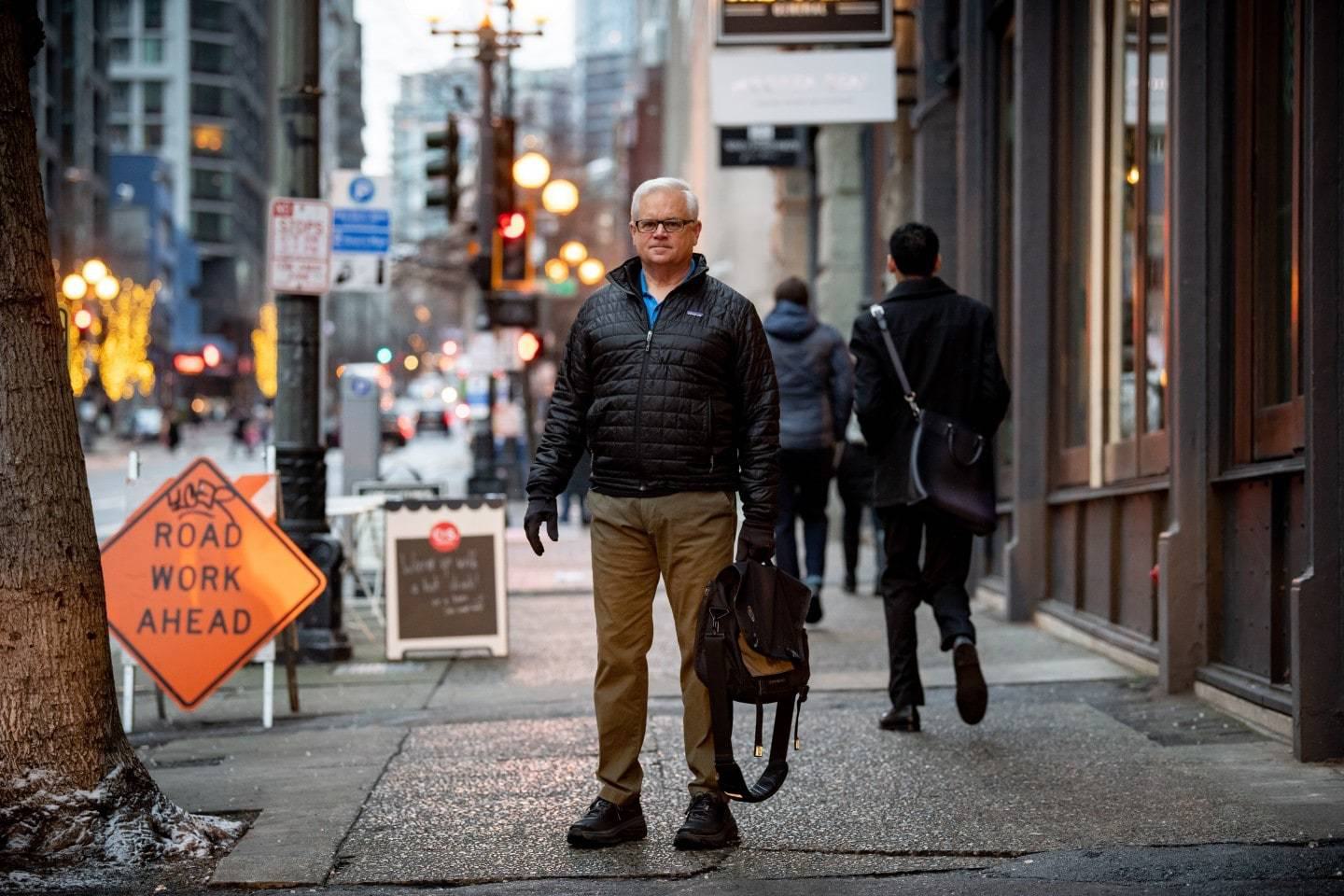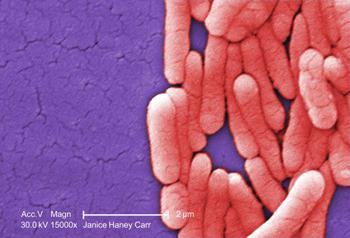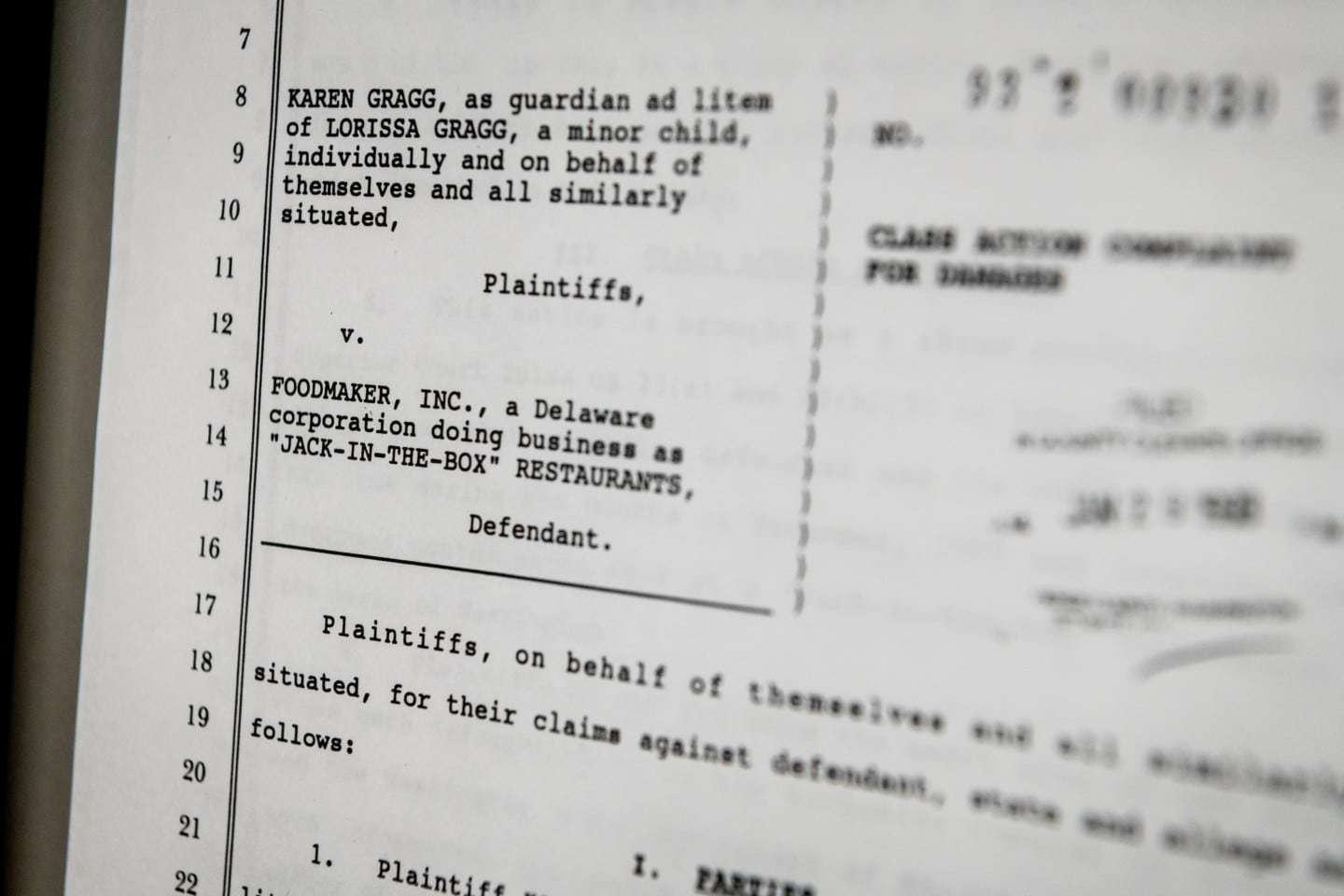From the Washington Post - Kimberly Kindy - 2020

Lawyer Bill Marler, 62, outside his office in downtown Seattle. (Stuart Isett/for The Washington Post)
Bill Marler, the Seattle lawyer who represented hundreds of victims in the Jack in the Box food poisoning case in the 1990s, was outraged by the avoidable tragedy that sickened 700 and claimed the lives of four children.
He courted the media to get the E. coli bacteria on the agenda of policymakers — and played a key role in getting the U.S. Department of Agriculture to outlaw the most virulent strains of the pathogen in meat.
Now, Marler, 62, is at it again. This time he is taking aim at salmonella, which over the past decade has become the most dangerous bacteria in meat.
On Sunday, Marler filed a petition with the USDA — just as he did regarding E. coli a decade ago — asking it to agree with his legal, scientific and moral arguments to ban dozens of salmonella strains from meat.
The USDA’s data shows that about 1 in every 10 chicken breasts, drumsticks or wings that consumers purchase is probably contaminated with salmonella, which largely comes from fecal matter getting on meat during slaughter.
“When I tell people that chicken manufacturers can knowingly and legally sell something that can kill you, they don’t believe me,” Marler said in an interview. People are equally surprised, he said, to learn that the federal government “stamps meat ‘USDA certified,’ all along knowing that it could be contaminated with cow or chicken” feces.
If the USDA approves the petition, the department would have far-reaching power to recall or seize meat for a variety of salmonella strains. It could also pull its inspectors from wayward meat plants, effectively shutting them down, a move that could cost big operations millions of dollars a day.

A microscopic image of clustered Gram-negative, Salmonella typhimurium bacteria, isolated from a pure culture. (Janice Haney Carr/CDC)
The meat industry opposes banning salmonella, saying the technology needed to prevent and eliminate the contamination has not yet been developed. It also argues that meat prices would rise for consumers.
“With E. coli, it was a wake-up call for an industry that wasn’t paying attention to that pathogen. The industry is not asleep at the wheel with salmonella,” said Mark Dopp, a vice president of the North American Meat Institute, a trade association. “We are doing everything we can think of. Declaring something to be an adulterant isn’t going to make us swim faster or harder. We are swimming as fast and hard as we can.’’
If the USDA moved forward with a ban, meat companies would be legally obligated to make sure the salmonella strains are not on their products before shipping them to restaurants or grocery stores. Marler’s petition calls for new regulations, which would spell out what meat companies must do to comply. That would include new testing for the pathogens.
Meat industry officials, federal regulators and food safety advocates all agree: Marler’s latest petition is audacious.
Rather than attempting to ban a handful of the very worst salmonella strains — a common approach with such petitions — Marler is seeking to label as “adulterants” 31 different salmonella types. The petition includes each type of salmonella responsible for recalls and outbreaks that have made people sick over the past two decades.
“It’s a big leap,” said Sarah Sorscher, deputy director of regulatory affairs at the Center for Science in the Public Interest, which is advocating for a ban of a narrower set of salmonella types. “One of my colleagues described his petition as a punch in the face. You know, maybe [the USDA] needs a punch in the face.”
The timing of the petition is also daring. The Trump administration has a track record for siding with industry, consistently resisting new policies or regulations proposed by public health advocates.
An attorney for the meat industry said Marler should not be underestimated. When Marler embraces a food safety solution, he can be unrelenting, as he was with E. coli.
“He fought that fight and surprisingly won,” said Al Maxwell, an Atlanta-based lawyer who represents food industry clients and has gone up against Marler in hundreds of food poisoning cases. “The meat industry said the sky was going to fall if the government declared the pathogens as adulterants, but that didn’t happen. Meat got safer.”

A copy of the first complaint filed against Jack in the Box for the 1993 E. coli outbreak hangs in Marler's office. (Stuart Isett)
Salmonella outbreaks
E. coli illnesses and outbreaks linked to meat — especially beef — have plummeted since the USDA banned the most dangerous strain in 1994 and six other deadly strains in 2011.
Salmonella illnesses and outbreaks, however, have remained stubbornly high.
The U.S. Centers for Disease Control and Prevention estimates that salmonella bacteria causes about 1.35 million infections, 26,500 hospitalizations and 420 deaths in the United States every year.
About one-third of those cases involve meat, the CDC says.
“The whole time I was there we had two recalls for salmonella. Now, there can be four or five a month,” said Richard Raymond, who was undersecretary for the USDA’s Food Safety and Inspection Service from 2005 to 2008. “The contamination rate with chickens is a particular embarrassment.”
CDC data shows that when salmonella outbreaks are linked to meat, chicken causes the most illnesses, followed by pork and then beef.
The USDA has rejected two salmonella petitions, both filed by Sorscher’s group, saying there wasn’t yet sufficient scientific data to support the ban of specific strains. The latest rejection came in 2018.
Raymond says the department is hesitant to ban salmonella because it fears the industry will launch a fierce and costly legal battle, as it has with other efforts by the USDA to limit the amount of salmonella allowed on meat.
Marler hopes his 62-page petition — which presents legal arguments against past positions by the USDA and the meat industry opposing such a ban — will mark a turning point.
The petition process is also a mandatory first step before a lawsuit can be filed against the federal government. Marler said he plans to take this next legal step if the USDA rejects his request.
The USDA said it has not yet reviewed Marler’s petition and could not comment on how it might respond.
The department said in a statement that it has made “significant advances” using other enforcement tools and cited the success of a four-year-old rule that limits the amount of salmonella allowed on chicken parts. The rate of contamination on chicken parts has dropped from 24 percent to 9 percent.
Even with this improvement, CDC data shows the rates of salmonella-related illnesses have remained steady.
“Chicken s--- shouldn’t be on chicken flesh, it should be in chickens’ guts. Period. End of story,” Marler said. “Same with cows and same with pigs. It shouldn’t be on our food.”
Marler contends that chicken, pork and beef start out as sterile and that salmonella does not naturally occur on meat. Humans and processing equipment, he said, spread the contamination during slaughter.
The North American Meat Institute and the National Chicken Council argue there is nothing unnatural about bacteria from an animal’s gastrointestinal tract ending up on meat. And although contamination typically happens as Marler describes, it’s not the only way.
Katie Rose McCullough, a food scientist with the meat institute, said unlike E. coli, salmonella can be part of the animal’s flesh — in the lymph nodes — which filter and collect potentially harmful pathogens to keep animals healthy. “You can’t remove all of it; that’s impossible,” she said.
The National Chicken Council says that one of the best ways to prevent illness is to cook meat at temperatures high enough to kill the bacteria. “Raw chicken, just like any other raw agricultural commodity, is not a sterile product, and no regulation will ever make it sterile,” the council said in a statement.
But Marler argues that making restaurant chefs and consumers fully responsible for killing the bacteria is foolhardy. In his petition, Marler repeatedly cited research that shows how rare it is for people to follow USDA safety instructions. “You can’t put this burden on the consumer — it doesn’t work,” he said.
'Put me out of business'

Marler at his Seattle office. Pathogens in food helped him build a lucrative law career. (Stuart Isett/for The Washington Post)
Marler’s role as a food safety crusader might seem odd.
The existence of pathogens in food helped him build a lucrative law career and move his family from a 500-square-foot cabin to a spacious home on bucolic Bainbridge Island, with views of Puget Sound.
In the 1990s and early 2000s, more than 90 percent of Marler’s legal cases involved victims sickened by E. coli in meat. After the ban took effect and reforms followed, he said these cases dwindled and now account for fewer than 5 percent of his firm’s caseload.
Victims of salmonella poisoning in meat now account for 20 percent of his practice, he said.
Marler says he wants to drastically reduce the salmonella cases at the Marler Clark law firm.
“Bill’s very common refrain to industry is, ‘Put me out of business,’ ” said Denis Stearns, who started the firm with Marler, after first being his adversary as legal counsel for Jack in the Box. “He means it. If he had to choose between being a lawyer or a food safety advocate, I'm confident he would chose the food safety advocacy.”
Maxwell, the food industry attorney, is convinced Marler is trying to prevent food poisoning. But he also says Marler has “a selfish reason” for wanting the ban on many types of salmonella.
Making the bacteria illegal in meat could help Marler quickly win settlements for his clients, Maxwell said, since food companies could no longer argue that his clients got sick because they undercooked their meat. It would be illegal for the pathogens to be there in the first place.
Marler can be disarmingly casual. He wears shorts and sweats to his fifth-floor office in downtown Seattle. He sits in a cubicle like the rest of his staff. But his devotion to cases, and an uncanny ability to simultaneously track dozens of them, can sometimes create a tense atmosphere in the firm.
When he asks for a document or other information from a staff member who doesn't have it, his green eyes burrow into the person.
“We call it Marlerizing,” said Peggy Paulson, who recently retired after working as his administrative assistant and bookkeeper for more than 20 years. “Just bug . . . whoever has it until they comply with what you want. Just Marlerize them.”
In his advocacy work, Marler uses his blog to hammer away at the policy and legislative changes he would like to see. He posts editorials throughout the day — many of them landing at 3 a.m. Pacific time — when people on the East Coast are just beginning their day, but when nearly everyone on the West Coast is still asleep.
He said he spends about $250,000 annually to help finance an online publication, Food Safety News, considered a must-read for food policy leaders that attracts 2.5 million page views each month.
When Marler gives speeches at meat industry and food safety conferences, he speaks of his clients by name. His voice sometimes trembles.
Their stories are woven into his 2009 E. coli petition to the USDA; they are also part of his salmonella petition he filed Tuesday.
There is Rick Schiller, a 57-year-old Californian, whose fiancé rushed him to the hospital, his leg swollen to three times its normal size, after eating chicken contaminated with salmonella. He now suffers from arthritis and diverticulitis of his colon.
And 10-year-old Mikayla Porter of Florida, who spent weeks in a hospital intensive-care unit because of salmonella poisoning from pork.
Putting a human face on food poisoning has worked for Marler in Washington.
After contaminated spinach and peanut butter killed at least a dozen people in the mid-to-late 2000s, Congress considered overhauling the Food and Drug Administration’s food safety laws. Instead of focusing on stopping the flow of poisoned food, the FDA would do more to prevent contamination. (The FDA regulates some aspects of food safety, as does the USDA. Critics, including Marler, say the two federal agencies have policies inconsistent with each other.)
Marler fought for the bill for years, spending his own money to fly clients in to tell their stories in congressional hearings and in meetings with lawmakers and FDA officials.
When the proposed Food Safety Modernization Act stalled in the Senate just before a holiday break in 2010, Marler passed out custom T-shirts to senators that had a small picture of him on the front with a red X over his face. On the back it said: “Put a trial lawyer out of business. Pass meaningful food safety legislation by Thanksgiving.”
It was viewed as a showboat move by some, but when the bill passed, members of Congress and their staffs recognized Marler. A staff member for Rep. Rosa L. DeLauro (D-Conn.), one of the most vocal proponents in the House, gave him a signed copy of the legislation, a nod to the outsize role the lawmaker and Hill staffers believed he played.